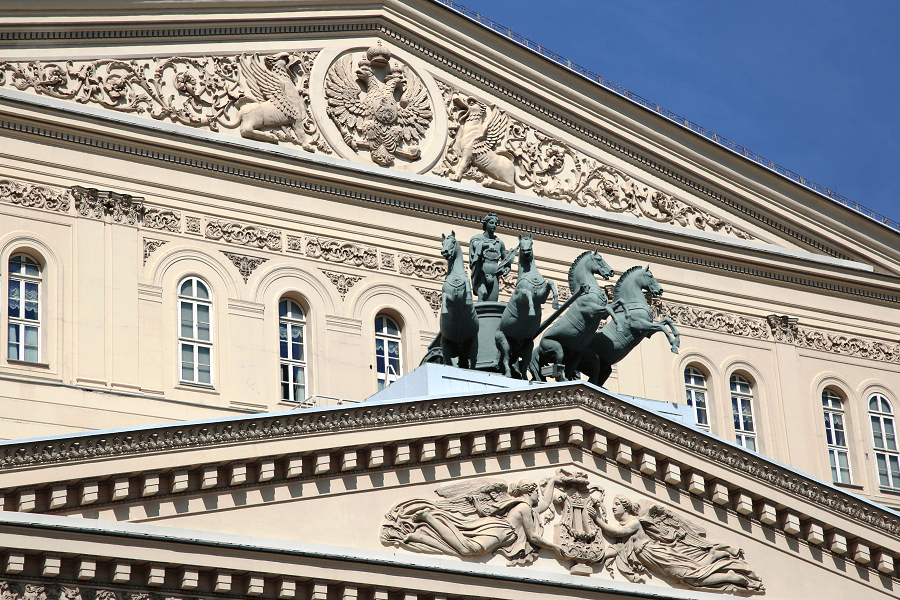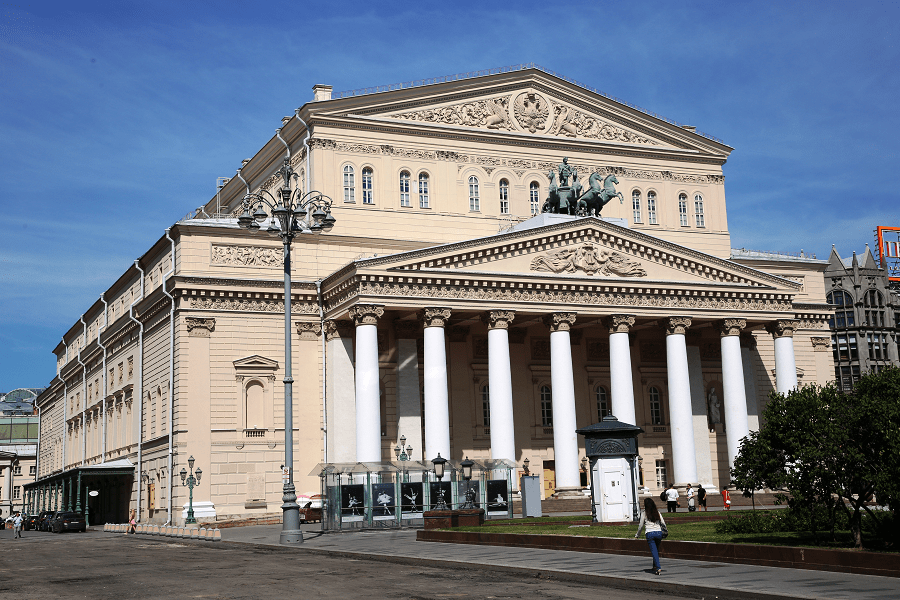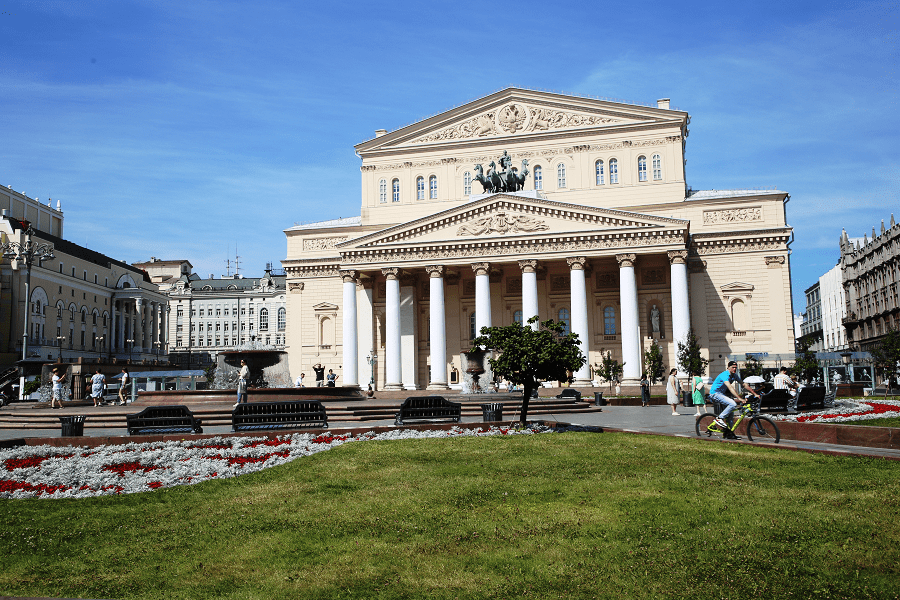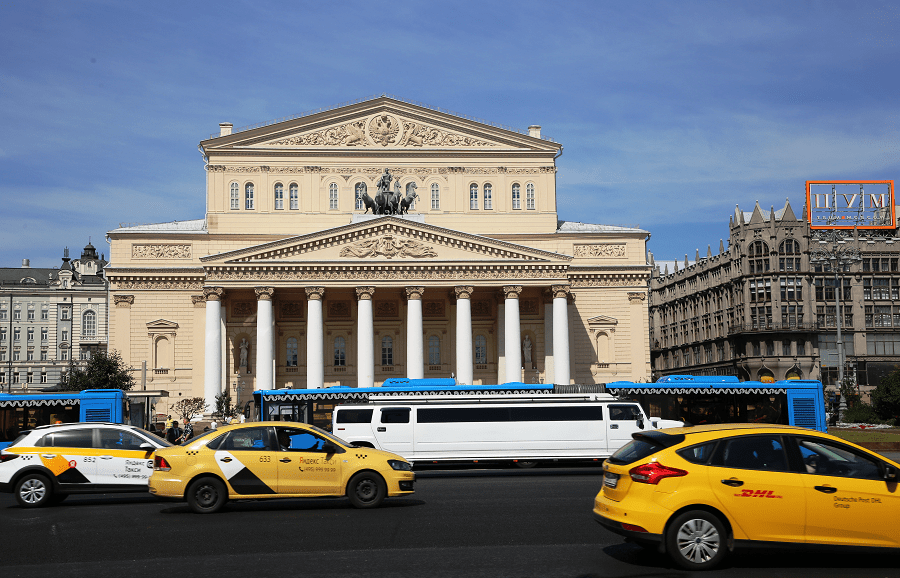The State Academic Bolshoi Theatre of Russia (Russian: Большой театр), or simply the Bolshoi Theatre is one of the largest in Russia and one of the most significant opera and ballet theaters in the world.
The complex of theater buildings is located in the center of Moscow, on Tetralnaya Ploschad. The Bolshoi Theatre, its museum, the building of the historical stage – an object of the cultural heritage of the peoples of Russia of federal significance.
Initially, the theater was private, but from 1794 it became state-owned, constituting, together with Maly theater, a single Moscow troupe of imperial theaters. From time to time, the status of the Moscow troupe changed each time it passed between the control of the Moscow Governor-General and the St. Petersburg directorate. This continued until the revolution of 1917 when all the property was nationalized and the Maly and Bolshoi theaters separated.
The entire history of theatrical culture in Moscow has long been associated with the Bolshoi Theatre.
The history of the theater starts from March 17, 1776, when the provincial prosecutor, Prince Pyotr Vasilyevich Urusov, received the highest permission of Empress Catherine II “to maintain … theatrical performances of all kinds, as well as concerts, vocals and masquerades.” The prince began the construction of the theater, which – at the location on Petrovka Street (on the right bank of the Neglinka) – was called Petrovsky. The Urusov Theater burned down even before its opening, and the prince handed over the business to his partner, the English businessman Michael Maddox. Under the leadership of Maddox, the Bolshoi Petrovsky Theater was built in 1776-1789 as part of the project of the architect Christian Rozberg. The theater was named after Petrovka Street, at the beginning of which it stood on a cramped lot amid buildings.
A three-story brick building with white stone details and under a plank roof rose in five months and cost Maddox 130,000 silver rubles, 50,000 more than the estimate. The grand opening took place on December 30, 1780. The theater had stalls, three tiers of boxes and a gallery that could accommodate about 1,000 spectators. The Petrovsky Theater of Maddox stood for 25 years – on October 8, 1805, the building burned down.
In 1816, the Commission on the construction of Moscow announced a competition for the construction of a new theater building. The winner of the competition was the project of the professor of the Imperial Academy of Arts A. A. Mikhailov. However, Mikhailov’s project was considered too expensive, and the theater building he had conceived, which was excessively large, did not correspond to the surrounding buildings. The revision of the project was entrusted to the architect Joseph Bové, who completely preserved the basics of Mikhailov’s composition, but significantly changed the proportions of the building, reducing its height from 41 to 37 meters and adjusting its exterior and interior decoration.
According to the plan of Bove, who put into practice the ideas of the general plan of Moscow developed by him and approved in 1817, the theater was to become the compositional center of the Empire city-temple, glorifying the victory in the Patriotic War. The strict rectangular square in front of the theater emphasized its greatness, andin the 1820s, it was called Petrovskaya and then renamed Teatralnaya. Bove brought the volume designed by Mikhailov in line with the square and turned Apollo’s quadriga towards the audience. The project for the construction of the theater was approved on November 10, 1821; even before the approval, Bove began to build the foundations of the theater according to his plan, while part of the foundations of the burnt building was preserved. The theater opened on January 6 (18), 1825. On March 11 (23), 1853 the theater burned down ina fire that lasted several days. Only the stone outer walls of the building and the colonnade of the portico survived.
The architects Konstantin Ton and Alexander Matveev and the chief architect of the Imperial Theaters Alberto Cavos were involved in the competition for the restoration of the theater. Cavos won and the theater was restored in three years. Basically, the volume of the building and the layout were preserved, but Cavos slightly increased the height of the building, changed the proportions and completely redesigned the architectural decor, making the facades in the spirit of early eclecticism. In place of the alabaster sculpture of Apollo that died in the fire, a bronze quadriga that Peter Klodt made was placed above the entrance portico. A plaster double-headed eagle – the state emblem of the Russian Empire – was installed on the pediment. The theater reopened on August 20, 1856, with Bellini’s opera.
The new stage of 2002
A new stage for the Bolshoi Theatre called the New Stage, went into service on 29 November 2002, constructed to the left of the theater’s historic main stage. Together with auxiliary buildings — a restored 17th-century building, two rehearsal halls, and artists’ recreation rooms — it forms a single theater complex, the Bolshoi Theatre of Russia. The new building is on a natural hill which it shared, until recently, blocks of old houses with communal apartments.
Organ
In 1913, the organ of the German firm Eberhard Friedrich Walcker, Opus 1738, 26/II/P, was installed at the Bolshoi Theatre. However, it did not survive. In 2013, a new wind organ that the German organ-building company Glatter-Goetz manufactured was installed. The installation of the instrument was completed in January, but the first time the organ sounded was on May 14 at a special gala presentation with the participation of Russian organists and musicians from the Bolshoi Theatre.
The instrument occupies seventh place among the wind organs of Moscow in terms of the number of registers. It is located behind the stage portal on the left side, in a special gallery located at a height of about 10 meters, which creates certain difficulties for the performers. All pipes are hidden in a wooden case.
Repertoire
More than 800 works were staged inthe theater during its existence. The first product created by the theater troupe was D. Zorin’s opera “Rebirth” (1777). The premiere of M. Sokolovsky’s opera “The Miller – ASorcerer, a Deceiver and a Matchmaker” (1779) had great success with the public, according to the memoirs of contemporaries. During this period of the theater’s existence, the repertoire was quite varied: operas by Russian and Italian composers, dance scenes from Russian folk life, divertissement ballets, and performances based on mythological subjects.
Working hours: daily, 11:00–20:00, break 16:00–18:00.
The cheapest ticket prices start from 2000 roubles and can only be bought on the official site.
Address: Theater Square, 1, Moscow.
Nearest metro: Teatralnaya, Ohotny Ryad, Ploschad Revolyutsii, Lubaynka.
Nearest attractions: Manezhnaya Square, Ploschad Revolyutsii (square), State Duma building, House of the Unions, Teatralnaya Ploschad, TSUM, Monument to Alexander Ostrovsky, Tretyakovskiy proezd, Central Children’s Store, Lubyanka Building, Metropol Hotel, Moskva hotel, Red Square, Tverskaya street, Kremlin.















